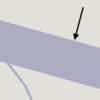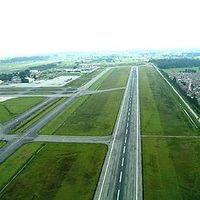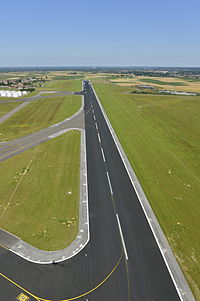Tag:aeroway=runway
| Description |
|---|
| A strip of land on which aircraft can take off and land. |
| Rendering in OSM Carto |

|
| Group: Aeroways |
| Used on these elements |
| Useful combination |
| See also |
| Status: de facto |
| Tools for this tag |
|
A runway is a defined rectangular area on a land aerodrome (aeroway=aerodrome) prepared for the landing and take-off of airplanes.
- For helicopter landing pads, use aeroway=helipad.
- For seaplane landing areas, use seamark:type=seaplane_landing_area.
How to Map
Draw a single way along the centreline (middle) of the runway, from one threshold to the other, and add the aeroway=runway to it. Information on the width of a runway should be added using the width=* tag (see below).
At one time, drawing the area of a runway and tagging with aeroway=runway is a common practice. If you wish to map the area a runway takes up (or encounter this), the area can be retagged with the combination area:aeroway=runway (similar to area:highway=*). Keep in mind taginfo reports aeroway=runway with combination area=yes has over 2500 uses while area:aeroway=runway has only 302 uses (1911 uses as at 4-2021).
Tags to use in combination
- ref=* - the runway designator (for example "02/20" or "09L/27R"). List the smallest designator first (i.e. "04/22", not "22/04"). The two designators of a runway will always differ by 18 (180 degrees) and can have one letter appended (L, C or R). Only use other values in special cases.
- length=* - can be used to hold the physical length of the runway surface, including aeroway=stopway, displaced threshold, etc. This is generally more than the length actually available for takeoff and landing. Use meters, or specify units. (100 for 100 meters, or 200' for 200 feet.
- width=* refers to the width of the actual runway surface e.g. the bitumen / short mown grass / compressed dirt. Runway widths are usually standardized, typical values are 60 m, 45 m, 30 m, 23 m or 18 m. Only use other values in special cases. You may also consider using width:strip=* to also indicate the cleared verges, which allow for wing overhang on both sides of the runway, and which are often marked by white cones.
- ele=* - should be used for the average elevation of the runway
- surface=* - to be used to identify the physical makeup of the surface of the runway. Example: "paved" or "grass".
- name=* - If the runway has a distinct name. Should not be a copy of ref. Examples: "Polderbaan" and "Aalsmeerbaan" at Amsterdam airport.
Additional information
Additional information can be specified using these keys:
| Tag | Description |
|---|---|
| Date | source:date=* - If imported/updated from the FAA 56-day NASR database, this tag will contain the date the database became valid. |
| Incline | Use the incline=[+|-]d.d% tag for the % incline of the runway. The direction of the way is from approach to departure. The incline is the elevation at the departure threshold minus the elevation at the approach threshold, divided by the distance between them. |
| Incline spec | incline:spec=[+|-]d.d%: the % incline of the runway, as specified in the FAA airport diagram. According to the legend diagram, this is measured to the midpoint of the runway (instead of the far threshold) if the runway is >= 8000ft, and is only specified if the absolute value is >= 0.3%. Note that this tag is used only if the incline is in the same direction as the runway. Otherwise, the reverse_incline tag is used (see reverse_incline:spec=* below). |
| Landing Facility Site Number | The FAA's Landing Facility Site Number for the airport with which the runway associated should be tagged with FAA:LFSN=*. There is generally no reason to edit this value - it is used to refer back to the associated aeroway=aerodrome node or way and the FAA database for synchronization of imports. Example: "01818.*A" is the LFSN for LAX. |
| Reverse incline | reverse_incline:spec=[+|-]d.d%: the % incline of the runway as specified in the FAA airport diagram, in the reverse direction of the OSM way. See incline:spec=* above. |
| Source | source=* - Source(s) of information present in tags, semi-colon-delimited if necessary. "FAA" indicates at least some information from one or more FAA databases or imports. Often combined with an imagery tag to indicate the imagery with which the boundary was drawn. |
| Source_ref | source_ref=* - Key to source documents. Example: when source=FAA, you may see source_ref=nnnnnAD, which indicates the document number of the FAA Airport Diagram, which are at http://aeronav.faa.gov/d-tpp/vvvv/''nnnnn''AD.PDF where vvvv is the version number (incremented every 56 days). |
| Lit | Add lit=* to indicate whether the runway is lit. If lit=yes is used, edge-lights are assumed to be present. Add lit:centre=yes to indicate the presence of centreline lights. |
Lifecycle
- Main article: Lifecycle_prefix
| stage | tagging | notes |
|---|---|---|
| construction | aeroway=construction construction=runway |
A runway under construction. |
| In operation | aeroway=runway | An operational runway |
| disused | disused:aeroway=runway | A runway not in use, which could be brought back into operation. |
| abandoned | abandoned:aeroway=runway | Where the runway fallen into serious disrepair and which could only be put back into operation with expensive effort. |
| No longer present on the ground | Remove from OSM or tag no:aeroway=runway | Where the runway is not evident on the ground it should be removed from OSM. If there is a danger of it being re-entered from old information then no:aeroway=runway signifies that it is no longer there. |
Example
| Picture/Description | Tags | OSM Carto |
|---|---|---|

|
aeroway=runway ref=06/24 |
See Munich International Airport for a reference.
See also
- aeroway=highway_strip - for an emergency strip on a roadway.
- aeroway=taxiway - for a taxiway used by aircraft to access runways from aircraft parking areas in an airport.
- aeroway=helipad - A landing area or platform designed for helicopters
- aeroway=launchpad - A launchpad or landing pad for spacecraft
External links
| ||||||||||||||||||||||||||||||||||||||||||||||

